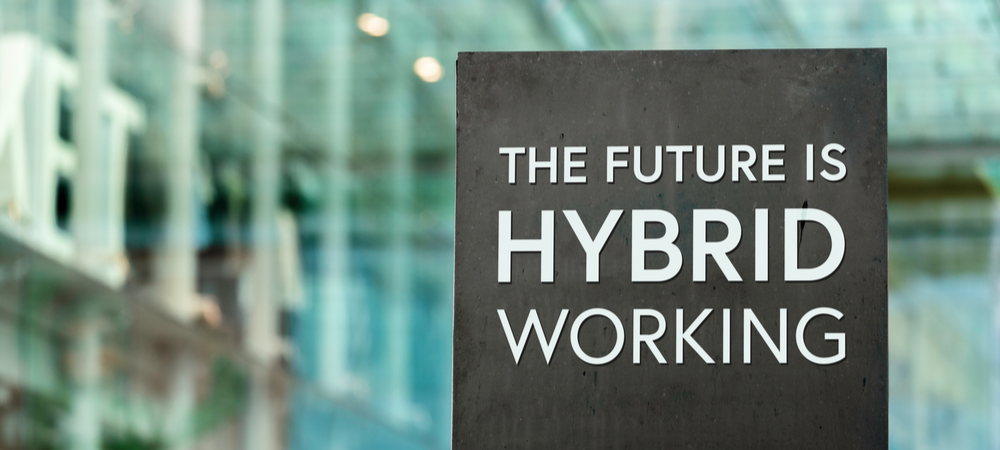
The New Era of Hybrid Working – Dealbreaker & Gamechanger
For most companies, the new “hybrid” reality means increasing flexibility of workspace and working hours coupled with a lot of change and new organizational models.
But the work performance results currently speak for themselves, as many employees work even more productively from home.
Hybrid Work - how much flexibility can your Organization tolerate?
“In this article, I’d like to share the most relevant insights from my consulting work with several large international clients to provide some guidance in the jungle of approaches to Hybrid Work.”
Peter is a partner and trainer at MDI, advising major international corporations on implementing hybrid work policies and building a hybrid work and leadership culture. He is considered an expert in training design. With his Webinar Guru Framework he has developed a tool that helps to design training content for successful and activating virtual learning.

Peter Grabuschnig - MDI Partner
Peter is a successful trainer, mindset coach and consultant.
The essence of work has changed not only in the last year and a half.
If we take a closer look at work over the course of the last few centuries, we see an exciting picture.
In the age of agriculture, work was defined by nature.
People oriented themselves and their work cycle to the weather and the seasons. When the sun was shining in spring, crops were sown, and when autumn came, they were harvested.
Then came factories and industry and revolutionized the world of work.
Suddenly, work was defined by the rhythm of machines and treadmills in production and the Industrial Age was born.
Not long ago, people sat in front of their computers and typed on their keyboards all day, they started working together and took breaks together, then went home at the same time in the evening.
Over the last few years, technology has advanced greatly
and has led to the fact that we, as humans, often no longer need to be continuously present in one place in order to do our work successfully.
Companies that have mostly run like well-oiled machines have not wanted to face this reality. After all, increasing flexibility in workspace and working hours would require too much change and new organizational models.
But then came the Corona Pandemic
and forced many companies to take this next, long overdue, evolutionary step in work organization.
Virtual working from home was suddenly possible
and practice proved in many cases that the fears of the board members did not materialize. The results of work performance spoke for themselves and many employees worked from home even more productively than in the office.

The “New Normal
The essence of work has changed even further, however, into the “new normal” everyone has been talking about since the pandemic – namely, a hybrid approach to work.
The new buzzword “hybrid” will be with us for a long time to come, and in the coming years it will prepare us even more for the Digital Revolution that is already waiting for us around the corner. These changes will take time, no revolution was won in a day, but the first stone has already been thrown and has led to a small whirlwind in some companies.
Where we work, how we work, and when we work with others will shift and change over time and companies will need to start adapting their processes, rules, and infrastructure to successfully accommodate this.
It will likely take at least another year or two for organizations and teams to figure out what the right rhythm is for them. This will also be significantly influenced by the industry in question, the ecosystems of the companies, as well as shareholders and stakeholders who want and need different things.
What our employees want
If we look at the current needs of employees in this context, we can see relatively quickly that a large proportion do not want to give up the flexible arrangements of virtual working, even after the pandemic.
This puts many classically organized companies in a bind.
- Only about 20% of employees want to return to the office. These are mainly younger people or people without a larger private environment who live alone and see their work as a place that also fulfills their social needs.
- On the other hand, there are 30% of employees who would prefer not to return to the office at all. This group includes people in their thirties and forties with families and a strong social environment at home, but also people who have a long commute to work.
- 50% of employees would prefer something in between, i.e. a hybrid set-up.
These figures alone show that as a company you are faced with completely different life realities and the wishes of your employees. And these have to be reconciled. This sounds like an increased organizational effort on the other side of which there are arguments like:
“Hybrid companies are 5% more productive” or “a hybrid setup makes employees significantly more satisfied”.
Especially in the current labor market and with the “War of Talent” heating up again, flexible work design has thus become inevitable for most companies.
Change everything - starting tomorrow, please!
As a company, you should take time right now, despite the great pressure from all sides,
to carefully examine possible next steps.
Using reorganization as an opportunity – Changing the Game
Talk to your management and your employees and don’t get carried away with quick decisions. Classically organized companies in particular should keep their distance from the trap into the ultimate agility, even if it may currently be tempting to make decisions quickly.
However, this new working reality naturally offers some great opportunities in addition to the risks, which we will highlight in the next point.
Hybrid Gamechangers:
- Take the opportunity to reflect on the last year and a half together with the team. What has worked well? What didn’t work so well? And above all: What do we want to take away from our experiences? The team retrospective method is a great way to do this.
- The reorganization can be taken as an opportunity to talk with the team and colleagues about the way we work together. In this way, the team can discuss roles, tasks, values, but also strengths and weaknesses together and establish a strong basis for the new challenges. For this, I can recommend the Team Canvas as a method.
- In addition, it might be time to critically examine your own business model once again and check whether new working models could have an impact on it. A nice method is the Business Model Canvas.
- It is also time to think about goal definitions. Is the classic and rather rigid approach of KPIs through “Management by Objectives” still suitable at all for the new working reality or should we rather think about introducing a more flexible system like OKR? After all, we don’t see our employees on a daily basis anymore, so we are moving away from the perception of defining performance by working hours and towards results as a measurable variable. The focus is on results and no longer on micro-processes. A recommendation at this point: the OKR-Facilitator course from MDI.
- On the one hand, employees are required to be flexible in their daily work, but on the other hand, a flexible work model also presents the company to the market as a modern and forward-looking company that helps to retain employees and attract new ones.
- The work-life balance of employees can be improved. Here I would like to explicitly point out the “can“, since employees usually work more in the home office than in the office and clear regulations and boundaries are needed in the system for this as well.
Stumbling blocks
these dealbreakers should be thought about beforehand
Hybrid dealbreakers:
First among the stumbling blocks, in my opinion, is the so-called “proximity bias.”
This means that we assume that people who are closer to us as a person, or to the team, perform better and are better workers. This can even lead to these people having more success in the company.
Proximity bias is not a new phenomenon, but the pandemic has reinforced it. Nevertheless, since 2015, there have been results of a large-scale study by Professor Bloom (Stanford University) showing that a person who works completely remotely has a fifty-fold lower chance of being promoted than a person who is in the office every day.
So, as a manager and as a company, one should be aware of this bias so as not to make decisions based on presuppositions that may not have any provable validity. When people who work at home or remotely get the feeling of being second choice, it creates an imbalance in the long run.
The second stumbling block is the fear of missing out, or FOMO for short.
People who are part of a team and have the feeling that they are missing out on something, or that they are not being included, quickly feel uncomfortable and become dissatisfied. A nice term is “democracy of the present” – meaning that people who are in regular contact decide important things together, leaving others out.
This phenomenon is not new either, though it has been significantly amplified by the Corona Pandemic. Imagine the following case: Three team members are sitting in the seminar room and attending the meeting from the office. Two other team members are connected from home. Important points are discussed and some, sometimes heated, discussions take place. At the end, everyone closes their laptops. For the participants at home, the meeting is over, but the three people in the room will probably continue to talk about the issues, perhaps even over coffee together. A classic case of FOMO.
As a third point, I would like to mention the so-called “presence inflation”.
Some employees are starting to come back to the office more than others. Thus, the others get the feeling that they stay at home too often. Here, the feeling should be conveyed that showing presence does not necessarily have anything to do with the fact that someone is in the office. Visibility and presence can be created just as much by not physically meeting.
Let’s move on to the biggest dealbreaker in the Hybrid Set-Up – “Input-Based Management.”
This refers to employees sitting at their desks, working hard, hitting the keys, and at least looking productive. The opposite of this would be “Output-Based-Management”, which focuses on what employees achieve. Are they hitting their quarterly targets, is the report ready by the deadline, are new products being developed, etc.? Input-based management is a disaster for managers who have employees working from home.
The question is whether Input-Based-Management is still practical at all, even for employees in the office. Inevitably, companies will have to address the issue of performance appraisal and define clear, understandable goals with teams and employees.
Secondarily, however, trust in one’s own employees will play a major role. Without a basic trust, a hybrid work set-up will pretty much not work.
The final dealbreaker is to bring employees into the office and require them to do tasks that they could do at home.
The only thoughts that arise in this case are control, pressure, dis-empowerment and lack of trust, which in turn is not a good basis for a functioning collaboration.

Back to the Office – What Now? Tips for the first steps.
I think what most companies are already aware of is that there needs to be a suitable technical set-up for merging the virtual world with office reality. In the last two years, a number of players have become well established in the market and many suitable software solutions are offered for a wide variety of initial situations. Investing and experimenting here will become an inevitable must in the future.
The first step is to take a close look at the main activities of your company.
If they produce software, there will be little in the way of a hybrid setup. However, if you are an industrial company, for example, you need to take a closer look at which areas of your work can be made more flexible, both now and in the years to come. It is important not to do the math without the employees. Get their opinions and ideas. This will help you create a sense of inclusion and possibly come up with new approaches and ideas. Especially for areas where you didn’t think home office days were possible until now, there may be creative possibilities.
It is also important for the team to consider how the time spent together in the office should be used in the first place.
Exchange, communication and creative joint processes, of course with a focus on work, should be planned and designed together. I hear time and again, especially from managers, that this new set-up means a lot of extra work. This fact is certainly not to be dismissed out of hand, yet it must also be made clear to managers that they do not have to handle all these tasks, such as planning and designing meetings, on their own. They can distribute a wide variety of organizational tasks within the team and also seek support there.
Employees who need more direction in their work are more likely to be brought back into the office.
In most cases, teams are set up in a diverse way, which is a good thing in itself. However, since self-organization is becoming more and more important in hybrid setups, employees who find this difficult are at a disadvantage. The idea that employees who need more direction in their work are more likely to be brought back into the office in order to be able to look after them better is therefore obvious. However, this is a relevant fallacy. The managers themselves are also in the home office to a certain extent, which means that the employee is not in the manager’s field of control. It is important to consider how directive leadership can also be implemented in a remote setup, e.g. through clear work packages, clearly defined and understandable goals and regular check-ins by telephone or conference call with the team member concerned.
Number and choice of home office days:
How much autonomy in making decisions?
The real question is not whether employees work flexibly or not, but who decides on the rules for this.
We can name three different approaches to this:
- The Individual Mode: each person decides individually on which days to work in the home office and on which days to work in the office. This can happen in agreement with the manager, but does not have to.
- Team mode: the team agrees or is instructed by the team leader on which days to work in the office and which to work at home. In this case, all team members are at home or in the office at the same time.
- The top management mode: The company management tells the teams when to work at home and when to work in the office.
Currently, most companies opt for the individual mode
which means that an individual agreement is made with each employee. Some of my clients do this in the form of different models that can be chosen, still others give the decision completely free, and still others give a maximum of 2 or 3 home office days per week, for example. The individual mode may have its appeal, but it presents companies with the challenge of having to function as a hybrid.
Especially in the beginning, the team mode can be recommended.
The team agrees on certain days that are spent together in the office and others that are spent at home. On the one hand, this reduces the flexibility a bit, but on the other hand it gives you more possibilities to combine both worlds well. In exceptional cases, the manager can still make flexible decisions.
When deciding on days, it is also important to consider the Monday/Friday dilemma.
After all, the most popular days for home office are Monday and Friday and the least popular is Wednesday. However, in many cases this will lead to offices being overcrowded on Wednesdays and mostly empty on Mondays and Fridays. Here you should pay attention to a good distribution.
Nothing has to be set in stone.
Especially when it comes to the choice of mode, but also with regard to all the agreements you currently make with your teams and employees – nothing has to be set in stone. Our working world is currently transforming – my invitation: Experiment! Preferably together with your team. Try out new models and, above all, take time to evaluate together with your team what works well and what should perhaps be discarded or adapted.
Your employees need one thing above all else now: clarity to plan their lives around the new arrangements.
Essentially, this transformation requires you to do one important thing: Communicate with your employees and listen to what they have to say to you!
I wish you every success for the leap into the age of hybrid work!
Leadership E-Learning
By the way, Peter shows you in our new e-learning course successful virtual collaboration & mentoring step by step!
Digital training formats for leadership development
We help make leadership development more agile with our digital training formats:
- E-learnings
- e-consulting
- Blended Learning Journeys
- Virtual Leadership
- virtual reality
- digital learning transfer
– we have just the right thing for your needs!



